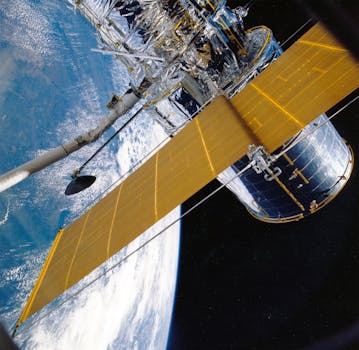Navigating the Skies: Insights into Recent Satellite Telecommunications Innovations

Navigating the Skies: Insights into Recent Satellite Telecommunications Innovations
Satellite telecommunications have come a long way since the launch of the first commercial communications satellite, Intelsat 1, in 1965. Over the years, significant advancements in technology have enabled the development of more efficient, reliable, and cost-effective satellite communication systems. Today, satellite telecommunications play a vital role in providing global connectivity, bridging the digital divide, and facilitating a wide range of applications, including navigation, remote sensing, and weather forecasting.
Introduction to Satellite Telecommunications
Satellite telecommunications involve the use of artificial satellites orbiting the Earth to transmit and receive data, voice, and video signals. The process begins with the transmission of signals from a ground station to a satellite, which then amplifies and retransmits the signals back to Earth, where they are received by another ground station or directly by the end-user. Satellite telecommunications offer several advantages, including global coverage, high bandwidth, and resistance to natural disasters and terrestrial infrastructure outages.
Recent Innovations in Satellite Telecommunications
Recent years have witnessed significant innovations in satellite telecommunications, driven by advances in technology and the growing demand for global connectivity. Some of the key innovations include the development of high-throughput satellites (HTS), which offer higher bandwidth and faster data transfer rates. HTS satellites use multiple spot beams to provide targeted coverage, increasing the overall capacity and efficiency of the satellite. Another significant innovation is the use of low-Earth orbit (LEO) satellites, which operate at altitudes of around 160 to 2,000 kilometers, offering lower latency and faster data transfer rates compared to traditional geostationary satellites.
The use of advanced materials and manufacturing techniques has also led to the development of smaller, lighter, and more fuel-efficient satellites. This has reduced the cost of launching satellites into orbit, making satellite telecommunications more accessible and affordable. Furthermore, the integration of artificial intelligence (AI) and machine learning (ML) algorithms has enabled the optimization of satellite communication systems, improving the efficiency and reliability of data transmission.
Applications of Satellite Telecommunications
Satellite telecommunications have a wide range of applications, including navigation, remote sensing, and weather forecasting. Navigation systems, such as GPS, rely on satellite telecommunications to provide location information and timing signals. Remote sensing applications, such as Earth observation and satellite imaging, use satellite telecommunications to transmit data and images from satellites to ground stations. Weather forecasting also relies on satellite telecommunications to transmit data from weather satellites to ground stations, enabling the prediction of weather patterns and storms.
In addition to these applications, satellite telecommunications play a critical role in providing global connectivity, particularly in areas where terrestrial infrastructure is limited or non-existent. Satellite-based internet services, such as those offered by HughesNet and Exede Internet, provide broadband access to remote and underserved communities, bridging the digital divide and enabling access to information, education, and economic opportunities.
Future Prospects and Challenges
The future of satellite telecommunications looks promising, with ongoing innovations and investments in new technologies and infrastructure. The development of 5G networks and the integration of satellite communications with other technologies, such as the Internet of Things (IoT), are expected to drive growth and demand for satellite telecommunications. However, there are also challenges to be addressed, including the increasing congestion of orbital slots, the need for spectrum management, and the risks associated with space debris and satellite collisions.
Despite these challenges, satellite telecommunications are poised to continue playing a vital role in providing global connectivity and facilitating a wide range of applications. As technology continues to evolve, we can expect to see even more innovative solutions and applications emerge, further transforming the way we communicate and access information.




